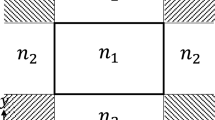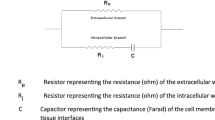Abstract
We describe a method for direct intercomparison of terahertz permittivities at 200 GHz obtained by a Vector Network Analyzer and a Time-Domain Spectrometer, whereby both instruments operate in their customary configurations, i.e., the VNA in waveguide and TDS in free-space. The method employs material that can be inserted into a waveguide for VNA measurements or contained in a cell for TDS measurements. The intercomparison experiments were performed using two materials: petroleum jelly and a mixture of petroleum jelly with carbon powder. The obtained values of complex permittivities were similar within the measurement uncertainty. An intercomparison between VNA and TDS measurements is of importance because the two modalities are customarily employed separately and require different approaches. Since material permittivities can and have been measured using either platform, it is necessary to ascertain that the obtained data is similar in both cases.





Similar content being viewed by others
Notes
This value of reflection actually corresponds to a height and width tolerance of 6.5 μm. However, this value is used here as it will provide a somewhat conservative estimate of the actual reflection produced by the waveguide apertures.
This is the IEEE 1785.2a ‘precision pin’ flange design described in [28].
References
Kazemipour, A.; See-Khee Yee; Hudlicka, M.; Salhi, M.; Kleine-Ostmann, T.; Schrader, T., “Design and calibration of a compact quasi-optical system for material characterization in millimeter/sub-millimeter wave domain,” Precision Electromagnetic Measurements (CPEM 2014), 2014 Conference on, pp.482,483, 24–29 Aug. 2014.
Kazemipour, A.; Hudlicka, M.; Kleine-Ostmann, T.; Schrader, T., “A reliable simple method to extract the intrinsic material properties in millimeter/sub-millimeter wave domain,” Precision Electromagnetic Measurements (CPEM 2014), 2014 Conference on, pp. 576–577, 24–29 Aug. 2014.
Puthukodan, S.; Dadrasnia, E.; Vinod, V.K.T.; Nguendon, H.K.; Lamela, H.; Ducournau, G.; Lampin, J.-F.; Garet, F.; Coutaz, J.-L.; Lee, D.-M.; Baik, S., “Sub-THz characterisation of multi-walled carbon nanotube thin films using vector network analyser,” Electronics Letters, vol.50, no.4, pp. 297–299, February 13, 2014.
Bin Yang, Hansheng Su and Robert S. Donnan, “Vector Network Analysis of Dielectric and Magnetic Materials in the Millimetre Wave Band”, Journal of Physics: Conference Series, vol. 286, 012019, 2011.
Bin Yang, Xinke Wang, Yan Zhang, and Robert S. Donnan, “Experimental characterization of hexaferrite ceramics from 100 GHz to 1 THz using vector network analysis and terahertz-time domain spectroscopy”, J Applied Physics, vol. 109, 033509, 2011.
Wenfeng Sun, Bin Yang, Xinke Wang, Yan Zhang, and Robert Donnan, “Accurate determination of terahertz optical constants by vector network analyzer of Fabry–Perot response”, Optics Letters, vol. 38, pp 5438–5441, 2013.
Woon-Gi Yeo; Nahar, N.K.; Volakis, J.L., “Validation of CW THz spectral measurements,” Antennas and Propagation Society International Symposium (APSURSI), 2012 IEEE, pp.1,2, 8–14 July 2012.
T. Tosaka, K. Fujii, K. Fukunaga, A. Kasamatsu, “Development of complex relative permittivity measurement system based on free-space in 220–330 GHz range,” IEEE Trans. THz Sci. Tech., vol. 5, pp. 102–109, 2015.
AB Millimeter MVNA-8-350 system: http://www.abmillimetre.com/Introduction.htm
M. Jaleel Akhtar, Lambert E. Feher, and Manfred Thumm, “Noninvasive Procedure for Measuring the Complex Permittivity of Resins, Catalysts, and Other Liquids Using a Partially Filled Rectangular Waveguide Structure”, IEEE Transactions On Microwave Theory And Techniques, vol. 57, pp 458–470, 2009.
Ugur Cem Hasar, “A Generalized Formulation for Permittivity Extraction of Low-to-High-Loss Materials From Transmission Measurement”, IEEE Transactions On Microwave Theory And Techniques, vol. 58, pp 411–418, 2010.
P. Kužel, H. Němec, F. Kadlec, C. Kadlec, “Gouy shift correction for highly accurate refractive index retrieval in time-domain terahertz spectroscopy”, Optics Express, vol 18, pp 15338–15348, 2010.
MIL-DTL-85/3D, “Waveguides, rigid, rectangular (millimetre wavelength)”, Apr. 2012.
G. F. Engen and C. A. Hoer, “Thru-Reflect-Line: An improved technique for calibrating the dual six-port automatic network analyser”, IEEE Trans. Microw. Theory Techn., vol. 27, no. 12, pp. 987–993, 1979.
N M Ridler, “Choosing line lengths for calibrating waveguide vector network analysers at millimetre and sub-millimetre wavelengths”, NPL Report TQE 5, National Physical Laboratory, Teddington, UK, 2009.
N M Ridler, R G Clarke, M J Salter and A Wilson, “The Trace is on Measurements: Developing Traceability for S-Parameter Measurements at Millimeter and Submillimeter Wavelengths”, IEEE Microwave Magazine, vol 14, no 7, pp 67–74, 2013.
N M Ridler, R G Clarke, M J Salter and A Wilson, “Traceability to National Standards for S-parameter Measurements in Waveguide at Frequencies from 140 GHz to 220 GHz”, Proc. 76th ARFTG Microwave Measurement Conference, pp 8–14, Clearwater Beach, FL, USA, Dec. 2010.
N M Ridler, “A review of existing national measurement standards for RF and microwave impedance parameters in the UK”, IEE Colloquium Digest, .no 99/008, pp. 6/1-6/6, Feb. 1999.
N M Ridler, “News in RF impedance measurement”, XXVIIth General Assembly of the International Union of Radio Science (URSI), The Netherlands, Aug. 2002.
Ioachim Pupeza, Rafal Wilk, and Martin Koch, “Highly accurate optical material parameter determination with THz time-domain spectroscopy”, Optics Express, vol 15, pp 4335–4350, 2007.
Peter Uhd Jepsen and Bernd M. Fischer, “Dynamic range in terahertz time-domain transmission and reflection spectroscopy”, Optics Letters, vol. 30, pp 29–31, 2005.
W Withayachumnankul, B M. Fischer, H Lin, D Abbott, “Uncertainty in terahertz time-domain spectroscopy measurement”, J Opt Soc Am B, vol 25, pp 1059–1072, 2008.
Standard Number: ASTM D5568-08, “Standard Test Method for Measuring Relative Complex Permittivity and Relative Magnetic Permeability of Solid Materials at Microwave Frequencies Using Waveguide”, ASTM International, Book of standards, vol. 10.02.
MATLAB-The Language of Technical Computing. Information available at: http://www.mathworks.com
M. Zeier, J. Hoffmann, and M. Wollensack, “Metas.UncLib-a measurement uncertainty calculator for advanced problems”, Metrologia, vol. 49, no. 6, pp. 809–815, 2012.
ISO/IEC Guide 98–3:2008, “Uncertainty of Measurement–Part 3: Guide to the expression of the Uncertainty in Measurement (GUM:1995)”, International Organization for Standardization, Geneva, Switzerland.
IEEE 1785.1-2012, “Standard for Rectangular Metallic Waveguides and Their Interfaces for Frequencies of 110 GHz and Above-Part 1: Frequency Bands and Waveguide Dimensions”.
A R Kerr, “Mismatch Caused by Waveguide Tolerances, Corner Radii, and Flange Misalignment”, Electronics Division Technical Note No 215, National Radio Astronomy Observatory, Charlottesville, VA, USA, 2009.
IEEE P1785.2-Committee Draft 2015, “Standard for Rectangular Metallic Waveguides and Their Interfaces for Frequencies of 110 GHz and Above-Part 2: Waveguide Interfaces”.
EURAMET, “Guidelines on the Evaluation of Vector Network Analysers (VNA)”, Calibration Guide cg-12, version 2.0, 03/2011, EURAMET e.V., Bundesallee 100, D-38116 Braunschweig, Germany.
N M Ridler and M J Salter, “Cross-connected Waveguide Lines as Standards for Millimeter-and Submillimeter-wave Vector Network Analyzers”, Proc. 81st ARFTG Microwave Measurement Conference, Seattle, WA, USA, June 2013.
N Shoaib, N M Ridler and M J Salter, “Commissioning of the NPL WR-05 Waveguide Network Analyser System for S-Parameter Measurements from 140 GHz to 220 GHz” NPL Report TQE 12, National Physical Laboratory, UK, March 2015.
Acknowledgments
This work was supported by the National Measurement Office of the UK.
Author information
Authors and Affiliations
Corresponding author
Rights and permissions
About this article
Cite this article
Naftaly, M., Shoaib, N., Stokes, D. et al. Intercomparison of Terahertz Dielectric Measurements Using Vector Network Analyzer and Time-Domain Spectrometer. J Infrared Milli Terahz Waves 37, 691–702 (2016). https://doi.org/10.1007/s10762-016-0256-y
Received:
Accepted:
Published:
Issue Date:
DOI: https://doi.org/10.1007/s10762-016-0256-y




